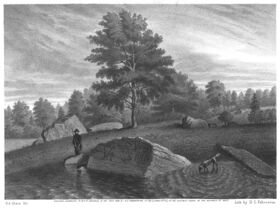Dighton Rock
From Kook Science
Dighton Rock is a 40 ton (36.29 mt) crystalline sandstone boulder into which have been carved petroglyphs of unknown origin, first recorded as having been discovered by Plymouth Colony settlers during 1680 in the shallows along the east bank of the Taunton River near the town of Dighton. In 1799, the land that the rock was located on was annexed by the town of Berkley, though kept the name of the former township; and it is currently held at the museum of Dighton Rock State Park in Berkley, Bristol Co., Massachusetts, where it was relocated during 1963.
Reading
- Delabarre, Edmund Burke (1919), Recent History of Dighton Rock, Cambridge: Wilson and Son, https://archive.org/details/recenthistoryofd20delauoft
- Hunter, Douglas (2017), The Place of Stone: Dighton Rock and the Erasure of America's Indigenous Past, University of North Carolina Press — "Claimed by many to be the most frequently documented artifact in American archeology, Dighton Rock is a forty-ton boulder covered in petroglyphs in southern Massachusetts. First noted by New England colonists in 1680, the rock's markings have been debated endlessly by scholars and everyday people alike on both sides of the Atlantic. The glyphs have been erroneously assigned to an array of non-Indigenous cultures: Norsemen, Egyptians, Lost Tribes of Israel, vanished Portuguese explorers, and even a prince from Atlantis."
